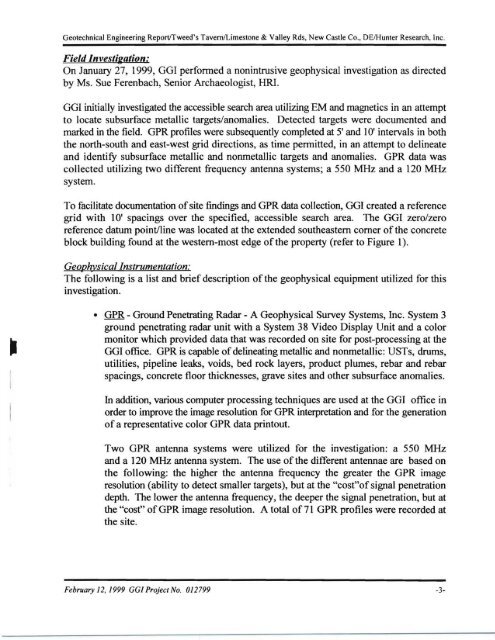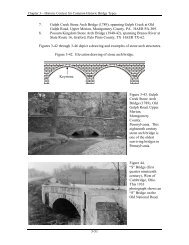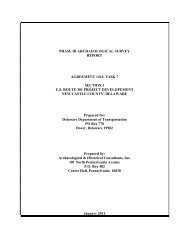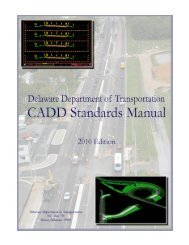Appendix E GEOTECHNICAL ENGINEERING REPORT GEO-GRAF ...
Appendix E GEOTECHNICAL ENGINEERING REPORT GEO-GRAF ...
Appendix E GEOTECHNICAL ENGINEERING REPORT GEO-GRAF ...
Create successful ePaper yourself
Turn your PDF publications into a flip-book with our unique Google optimized e-Paper software.
Geotechnical Engineering ReportlTweed's TavemlLimestone & Valley Rds, New Castle Co., DEIHunter Research, Inc.<br />
Field Investigation:<br />
On January 27, 1999, GGI performed a nonintrusive geophysical investigation as directed<br />
by Ms. Sue Ferenbach, Senior Archaeologist, HRI.<br />
GGI initially investigated the accessible search area utilizing EM and magnetics in an attempt<br />
to locate subsurface metallic targets/anomalies. Detected targets were documented and<br />
marked in the field. GPR profiles were subsequently completed at 5' and 10' intervals in both<br />
the north-south and east-west grid directions, as time permitted, in an attempt to delineate<br />
and identify subsurface metallic and nonmetallic targets and anomalies. GPR data was<br />
collected utilizing two different frequency antenna systems; a 550 MHz and a 120 MHz<br />
system.<br />
To facilitate documentation ofsite findings and GPR data collection, GOI created a reference<br />
grid with 10' spacings over the specified, accessible search area. The GGI zero/zero<br />
reference datum point/line was located at the extended southeastern comer of the concrete<br />
block building found at the western-most edge of the property (refer to Figure 1).<br />
Geophysical Instrumentation:<br />
The following is a list and brief description of the geophysical equipment utilized for this<br />
investigation.<br />
• GPR - Ground Penetrating Radar - A Geophysical Survey Systems, Inc. System 3<br />
ground penetrating radar unit with a System 38 Video Display Unit and a color<br />
monitor which provided data that was recorded on site for post-processing at the<br />
GOI office. GPR is capable of delineating metallic and nonmetallic: USTs, drums,<br />
utilities, pipeline leaks, voids, bed rock layers, product plumes, rebar and rebar<br />
spacings, concrete floor thicknesses, grave sites and other subsurface anomalies.<br />
In addition, various computer processing techniques are used at the GGI office in<br />
order to improve the image resolution for GPR interpretation and for the generation<br />
of a representative color GPR data printout.<br />
Two GPR antenna systems were utilized for the investigation: a 550 MHz<br />
and a 120 MHz antenna system. The use of the different antennae are based on<br />
the following: the higher the antenna frequency the greater the GPR image<br />
resolution (ability to detect smaller targets), but at the "cost"of signal penetration<br />
depth. The lower the antenna frequency, the deeper the signal penetration, but at<br />
the "cost" of GPR image resolution. A total of 71 GPR profiles were recorded at<br />
the site.<br />
February 12,1999 GGI Project No. 012799 -3






